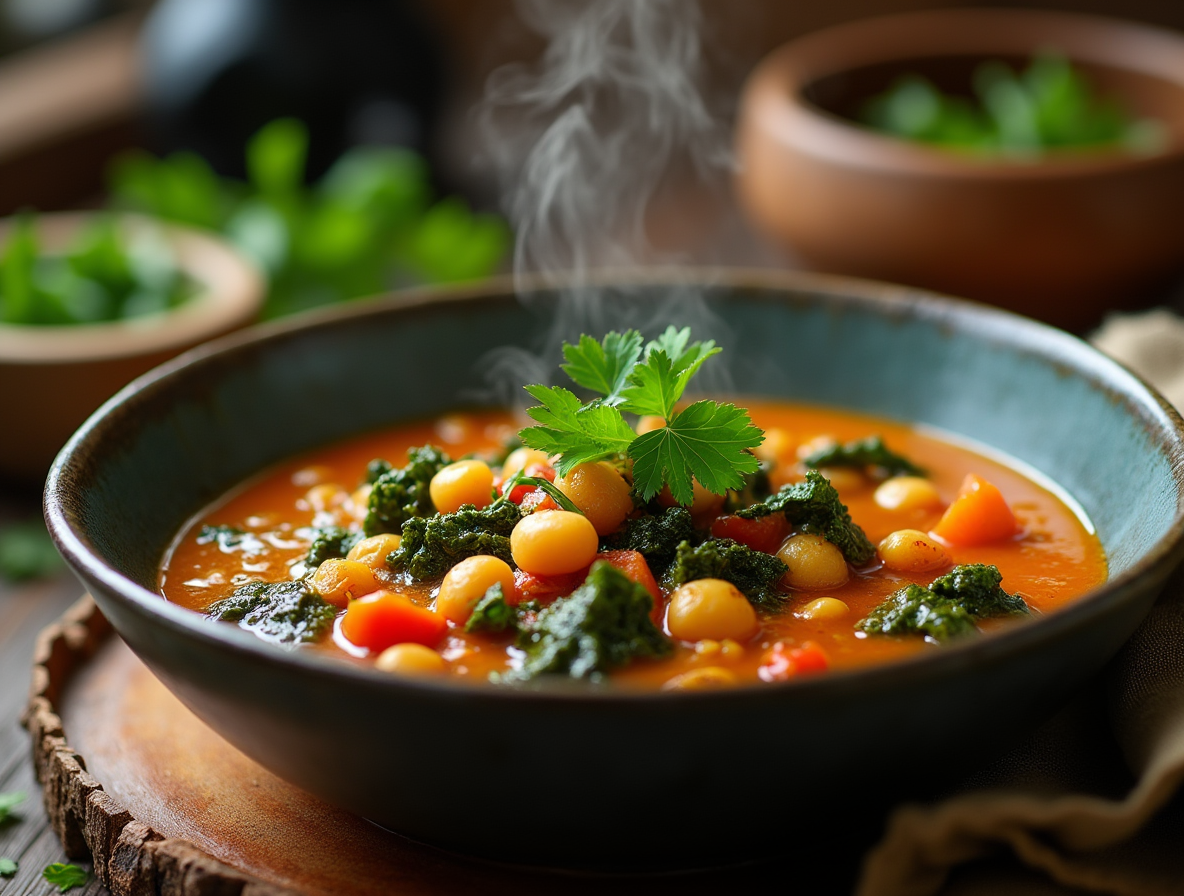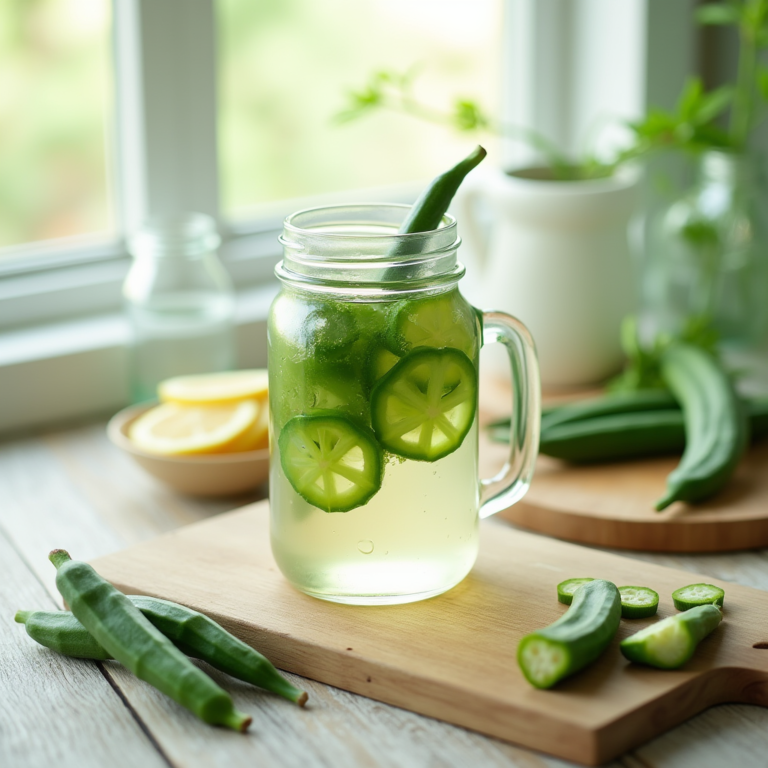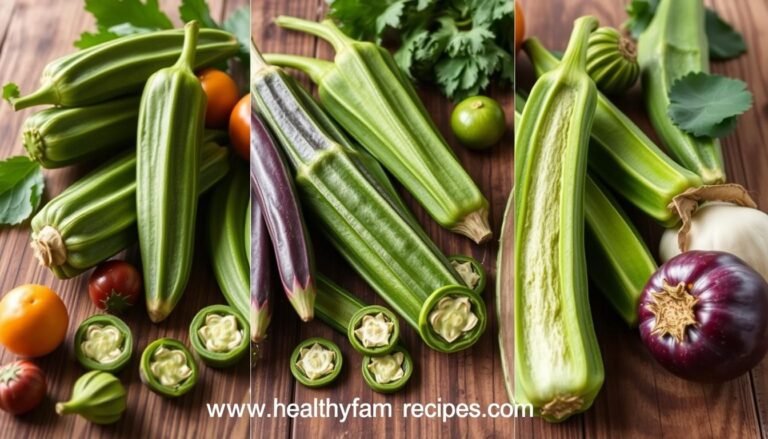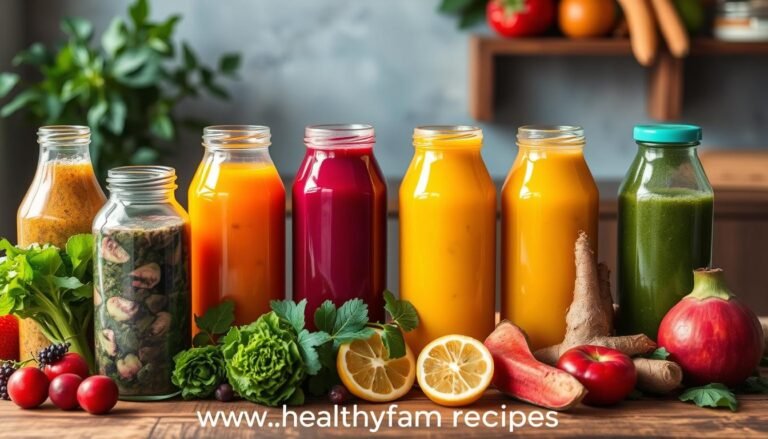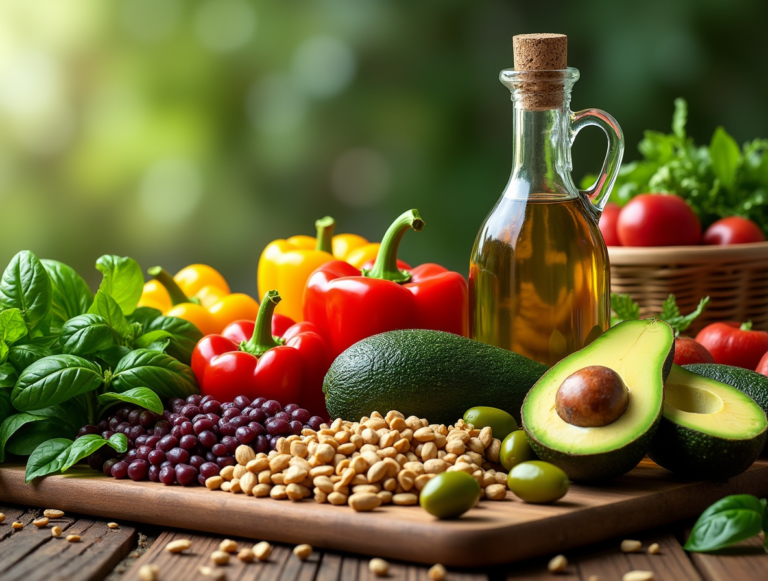Anti-Inflammatory Chickpea and Kale Soup: How to Make It Perfect
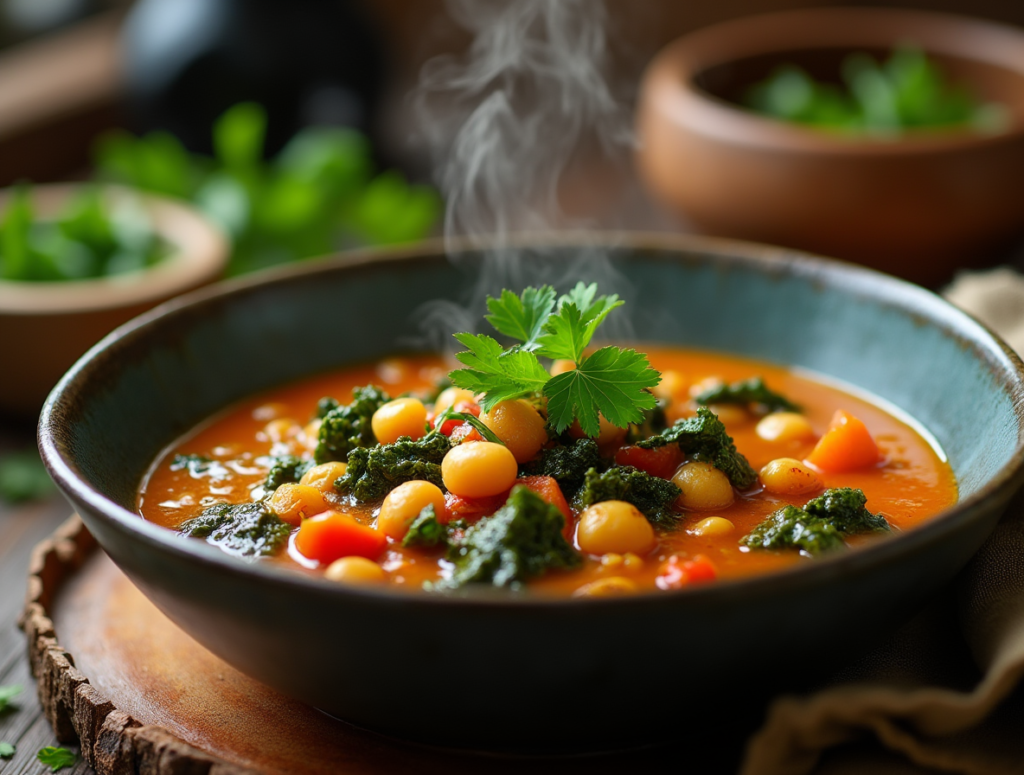
Table of Contents
Introduction: A Soup That Heals and Comforts
Imagine coming home to the smell of a nourishing soup. This Anti-Inflammatory Chickpea and Kale Soup is more than food. It boosts your immune system and fights inflammation, all while tasting great.
It’s perfect for when you’re feeling down, have sore joints, or want to eat healthier. It’s quick, easy, and packed with nutrients. It’s a great choice for your meals.
The Story Behind Anti-Inflammatory Chickpea and Kale Soup
This recipe combines comfort and nutrition. It fights inflammation, which is linked to many health problems. Chickpeas, kale, and turmeric are the main ingredients. They work together to make a delicious and healthy soup.
Why Choose Anti-Inflammatory Chickpea and Kale Soup?
- Easy to Prepare: It’s simple and cooks in one pot, great for busy people.
- Budget-Friendly: Chickpeas and kale are cheap and easy to find, making them affordable.
- Customizable: You can change it to fit your diet by swapping or adding ingredients.
- Meal Prep Friendly: Make a big batch for easy meals all week.
Ingredients: A Symphony of Health
Here’s what’s in the soup and why:
Base Ingredients
- Olive Oil (2 tablespoons): Good for your heart and fights inflammation.
- Onion (1 large, diced): Adds sweetness and is full of antioxidants.
- Garlic (3 cloves, minced): Boosts your immune system and fights inflammation.
Vegetables
- Carrots (2, sliced): Sweet and full of beta-carotene.
- Celery (2 stalks, chopped): Adds crunch and flavor.
- Kale (4 cups, chopped): Packed with vitamins and antioxidants.
Proteins and Flavor Enhancers
- Chickpeas (2 cans, 15 ounces each, drained and rinsed): Plant-based protein and fiber.
- Vegetable Broth (6 cups): Makes the soup flavorful.
Spices and Herbs
- Turmeric (1 teaspoon): Rich in curcumin, fights inflammation.
- Cumin (1 teaspoon): Warm, earthy flavor.
- Smoked Paprika (1/2 teaspoon): Adds smoky depth.
- Red Pepper Flakes (1/4 teaspoon, optional): For a spicy kick.
Finishing Touches
- Diced Tomatoes (1 can, 14.5 ounces): Add acidity and balance to the soup.
- Lemon Juice (1 lemon): Brightens the flavor and enhances the absorption of curcumin from turmeric.
- Fresh Parsley (for garnish): Adds freshness and a pop of color.
- Salt and Black Pepper (to taste): Essential for seasoning.
Step-by-Step Instructions: Making the Perfect Anti-Inflammatory Chickpea and Kale Soup
1. Prepare Your Ingredients
Before cooking, chop, dice, and measure everything. This makes cooking easier.
2. Sauté Aromatics
Heat olive oil in a large pot over medium heat. Add the diced onion and cook until translucent, about 5 minutes. Then, stir in the minced garlic, sliced carrots, and chopped celery. Cook for another 3 minutes, allowing the vegetables to soften slightly.
3. Toast the Spices
Add turmeric, cumin, smoked paprika, and red pepper flakes (if using) to the pot. Stir well to coat the vegetables in the spices. Toasting the spices releases their essential oils and enhances their flavor.
4. Build the Broth
Pour in the vegetable broth and add the chickpeas and diced tomatoes. Stir everything together and bring the mixture to a gentle boil. Reduce the heat to a simmer.
5. Simmer and Soften
Let the soup simmer uncovered for about 20 minutes. This allows the flavors to meld and the vegetables to soften to perfection.
6. Add the Kale
Stir in the chopped kale and let it cook for 5 minutes, or until wilted but still vibrant green. Kale retains its nutrients best when cooked gently.
7. Finish with Lemon and Parsley
Remove the pot from heat. Stir in the lemon juice to brighten the flavors, and season with salt and black pepper to taste. Ladle the soup into bowls and garnish with fresh parsley.
8. Serve and Savor
Serve hot with crusty bread, a side salad, or simply on its own. Enjoy the comforting warmth and health benefits of this nourishing soup.
Pro Tips for Success
- Make It Creamy: For a creamier soup, blend half of the soup using an immersion blender before adding the kale.
- Add Grains: For a heartier meal, stir in cooked quinoa, brown rice, or farro.
- Spice It Up: Adjust the spice level to your liking with more red pepper flakes or a dash of cayenne.
- Batch Cooking: Double the recipe and freeze individual portions for quick meals.
Health Benefits: A Deep Dive
1. Chickpeas: The Protein Powerhouse
Rich in fiber, chickpeas aid digestion and help regulate blood sugar levels. They’re also an excellent source of plant-based protein, making this soup a satisfying meatless option.
2. Kale: A Nutritional Superstar
Packed with vitamins A, C, and K, as well as calcium and iron, kale supports immune function, bone health, and energy levels. Its antioxidants fight free radicals and reduce inflammation.
3. Turmeric: Nature’s Anti-Inflammatory
Curcumin, the active compound in turmeric, has been extensively studied for its ability to reduce inflammation and oxidative stress. Pairing turmeric with black pepper (which contains piperine) boosts its bioavailability.
4. Olive Oil: A Heart-Healthy Fat
Extra virgin olive oil is rich in monounsaturated fats and polyphenols, which promote cardiovascular health and reduce inflammation.
Anti-Inflammatory Chickpea and Kale Soup for Kids, Elderly People, and Special Diets
This recipe can be tailored for various needs and tastes. It’s great for kids, the elderly, and those with special diets. These tweaks make it both healthy and tasty for everyone.
Anti-Inflammatory Chickpea and Kale Soup for Kids

Kids have their likes and dislikes, especially when it comes to food. Here’s how to make this soup appealing to them:
1. Make It Creamy
Kids like smooth foods. Blend the soup to make it creamy. This makes it easier for them to eat. Add Greek yogurt for extra creaminess.
2. Adjust Spices
Use mild flavors for kids. Omit the red pepper flakes and smoked paprika. Use garlic and turmeric instead for a gentle warmth.
3. Add Familiar Ingredients
Make it fun by adding small pasta shapes. Try alphabet pasta or orzo. Cook it separately and add it to the bowl.
4. Sneak in Vegetables
Blend in extra veggies like sweet potatoes or zucchini. This adds nutrients without changing the texture too much.
5. Serve with Fun Garnishes
Top it with cheese croutons or goldfish crackers. These add fun and a familiar taste.
Anti-Inflammatory Chickpea and Kale Soup for Elderly People
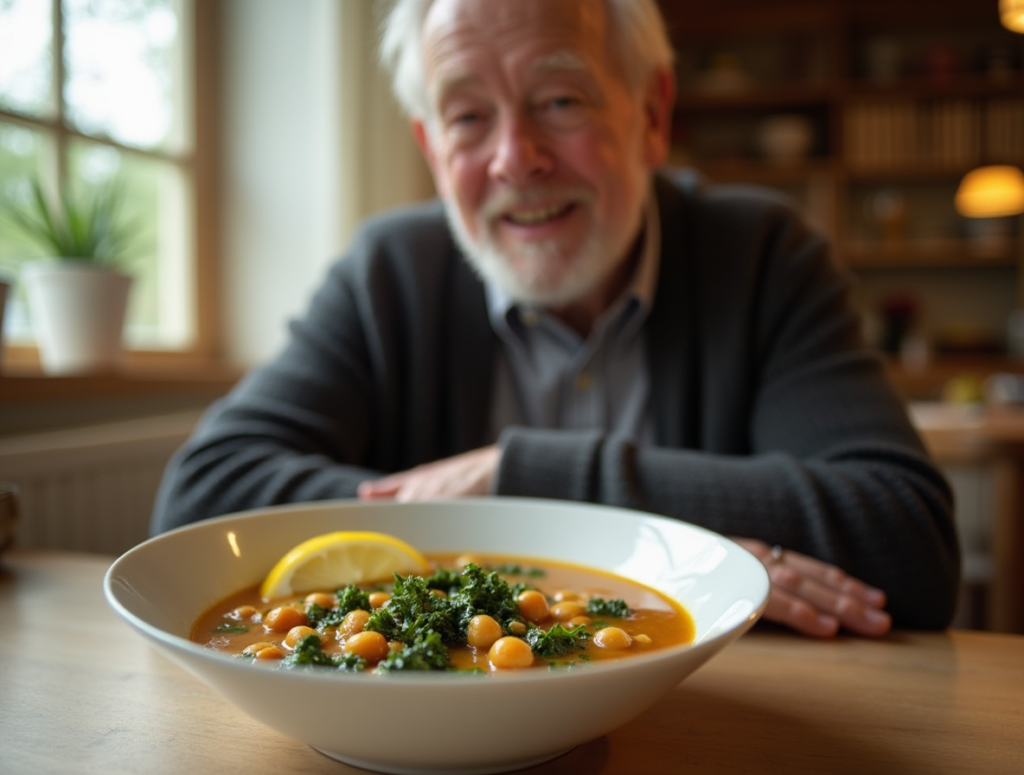
Elderly folks might have trouble chewing or eating less. Here’s how to make the soup easier for them:
1. Softened Texture
Make the soup very soft. Blend half of it and keep some chickpeas and veggies for texture.
2. Fortify with Protein
Add protein like silken tofu or soft-cooked quinoa. These are easy to eat and full of nutrients.
3. Lower Sodium
Use low-sodium broth and season lightly. Let them adjust the salt at the table.
4. Enhance Flavor Without Spices
Use lemon juice, fresh herbs, and olive oil for flavor. This avoids strong spices.
5. Include Digestive Support
Add a bit of fennel or ginger. These help with digestion and can ease stomach issues.
Anti-Inflammatory Chickpea and Kale Soup for Special Diets
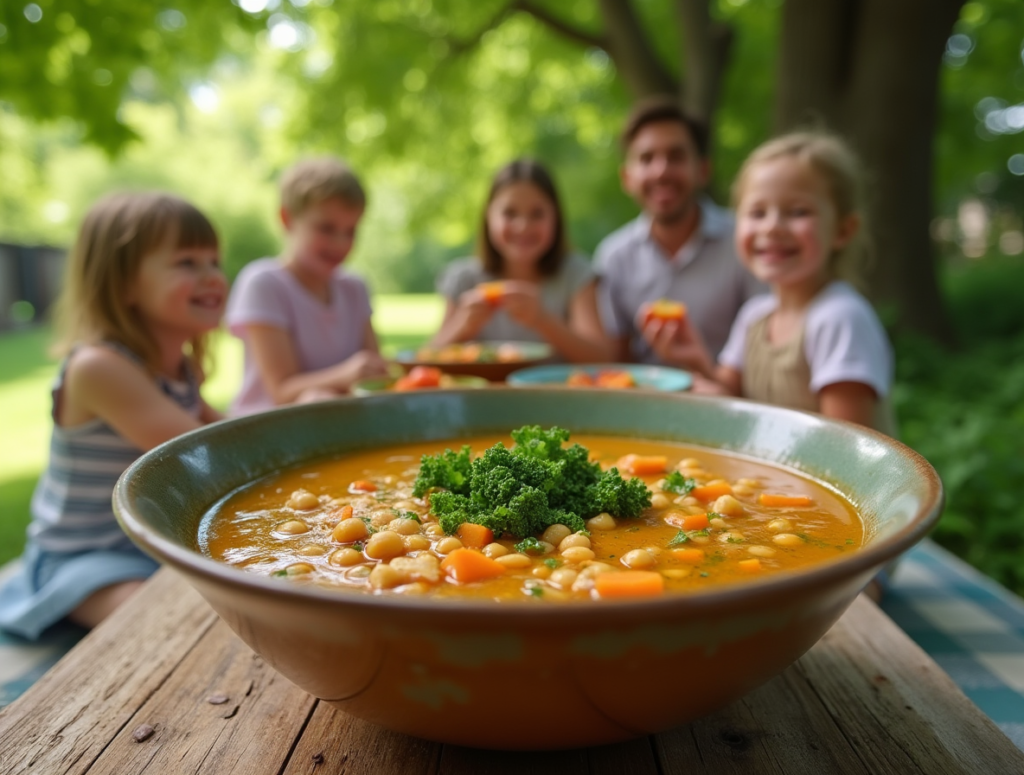
1. Gluten-Free
This soup is gluten-free. But, be careful of cross-contamination. Use gluten-free broth to keep it safe for those with gluten issues.
2. Dairy-Free/Vegan
The recipe is already vegan and dairy-free. For creaminess, blend with soaked cashews or add coconut milk.
3. Low-Carb/Keto
Replace chickpeas with zucchini or cauliflower. This lowers carbs and keeps the soup hearty.
4. High-Protein
Add chicken, turkey, or tofu for more protein. Or blend in white beans for plant-based protein.
5. Anti-Allergy
For legume allergies, use sweet potatoes or winter squash. They’re nutritious and fit the anti-inflammatory theme.
Five Alternatives for the Base Ingredients
When you can’t find certain ingredients, these substitutes keep your soup tasty and healthy.
1. Chickpea Substitutes
- Cannellini Beans: These white beans are mild and creamy, making them a perfect substitute for chickpeas.
- Lentils: Green or brown lentils cook quickly and provide a similar protein and fiber boost.
- Edamame: Shelled edamame adds a slightly nutty flavor and is rich in protein.
- Sweet Potatoes: Cubed sweet potatoes bring natural sweetness and a smooth texture to the soup.
- Cauliflower Florets: Use lightly steamed or roasted cauliflower for a low-carb alternative.
2. Kale Substitutes
- Spinach: Fresh or frozen spinach wilts quickly and integrates well into the soup.
- Swiss Chard: Chard has a similar nutritional profile and adds a slightly earthy flavor.
- Collard Greens: These greens are sturdy and hold up well in soups.
- Broccoli Leaves: If available, broccoli leaves are nutrient-dense and similar to kale in texture.
- Napa Cabbage: Thinly sliced napa cabbage adds a tender, mild flavor.
3. Vegetable Broth Substitutes
- Chicken Broth: If not adhering to a vegetarian or vegan diet, chicken broth works well as a replacement.
- Homemade Stock: Use homemade vegetable or bone broth for a richer flavor.
- Miso Broth: Miso paste mixed with water provides a savory umami boost.
- Tomato Juice: Use diluted tomato juice for a tangy, tomato-based broth.
- Coconut Water: While unconventional, coconut water can add a slight sweetness and light base.
4. Diced Tomato Substitutes
- Tomato Sauce: Substitute with plain tomato sauce for a smoother consistency.
- Fresh Tomatoes: Chop fresh tomatoes and cook them down slightly before adding.
- Roasted Red Peppers: Blend roasted red peppers for a smoky, sweet alternative.
- Pumpkin Puree: For a fall-inspired twist, use canned or fresh pumpkin puree.
- Sun-Dried Tomatoes: Chop finely and rehydrate in water before adding to the soup.
5. Turmeric Substitutes
- Curry Powder: Contains turmeric along with other complementary spices.
- Ginger: Fresh or ground ginger adds a similar warming effect.
- Saffron: For a unique flavor and yellow hue, saffron can be a luxurious substitute.
- Paprika: Smoked or sweet paprika provides a distinct depth of flavor.
- Yellow Mustard Powder: Adds a mild tang and mimics the color of turmeric.
Example Variations of Anti-Inflammatory Chickpea and Kale Soup
1. Mediterranean Style
- Add sliced olives, sun-dried tomatoes, and a sprinkle of feta cheese for a Mediterranean flair.
- Replace kale with arugula for a peppery kick.
2. Thai-Inspired
- Incorporate coconut milk, red curry paste, and a splash of lime juice.
- Replace chickpeas with tofu cubes or shredded chicken.
3. Middle Eastern Twist
- Add harissa paste for heat and a drizzle of tahini for creaminess.
- Top with fresh mint and toasted pine nuts.
4. Winter Vegetable Soup
- Use cubed butternut squash, parsnips, and turnips instead of chickpeas and kale.
- Flavor with rosemary and thyme for a cozy, seasonal dish.
5. Protein-Packed Quinoa Soup
- Replace chickpeas with cooked quinoa for a lighter texture.
- Add shredded turkey or chicken for extra protein.
Conclusion
Adding anti-inflammatory foods to your diet can greatly improve your health. This recipe is perfect for a quick family dinner. It combines healthy ingredients in a tasty broth that everyone will love.
Ingredients:
- 2 tablespoons olive oil
- 1 large onion, diced
- 3 garlic cloves, minced
- 2 carrots, sliced
- 2 celery stalks, chopped
- 1 teaspoon ground turmeric
- 1 teaspoon ground cumin
- 1/2 teaspoon smoked paprika
- 1/4 teaspoon red pepper flakes (optional)
- 6 cups vegetable broth
- 2 cans (15 ounces each) chickpeas, drained and rinsed
- 4 cups chopped kale
- 1 can (14.5 ounces) diced tomatoes
- Salt and black pepper to taste
- Juice of 1 lemon
- Fresh parsley, chopped (for garnish)
Instructions:
- Sauté Aromatics: Heat olive oil in a large pot over medium heat. Add diced onions and cook until they’re translucent about 5 minutes. Then, add minced garlic, sliced carrots, and chopped celery. Cook for another 3 minutes.
- Add Spices: Stir in ground turmeric, cumin, smoked paprika, and red pepper flakes (if using). Cook for 1 minute until the spices smell good.
- Combine Base Ingredients: Pour in the vegetable broth and add the chickpeas and diced tomatoes. Bring to a boil, then lower the heat to a simmer.
- Simmer Soup: Let the soup simmer uncovered for 20 minutes. This lets the flavors mix and the vegetables get soft.
- Incorporate Kale: Add the chopped kale to the pot, stirring until it’s wilted, about 5 minutes.
- Season and Serve: Season with salt and black pepper to taste. Stir in the lemon juice just before serving. Serve in bowls, garnish with fresh parsley, and enjoy!
Health Benefits Tailored to All Groups
- For Kids: Boosts immunity, supports growth with protein and vitamins and sneaks in vegetables effortlessly.
- For Elderly People: Soft textures and easy-to-digest ingredients support digestive health, while nutrient density combats age-related deficiencies.
- For Special Diets: The flexibility of this recipe ensures that everyone, regardless of dietary restrictions, can enjoy a wholesome, balanced meal. Conclusion: Nourish Your Body and Soul with Anti-Inflammatory Chickpea and Kale SoupThis Anti-Inflammatory Chickpea and Kale Soup is more than a recipe. It’s a choice for health and well-being. It’s perfect for kids, the elderly, and those with special diets. The soup is simple to make with just a few ingredients. It’s great for busy days and can be customized for everyone. This makes it a versatile and nutritious option. It’s a lifesaver for families, adding essential nutrients in a tasty way. It’s also great for those looking to reduce inflammation. Plus, it’s a blank canvas for creative cooking. If you’re new to plant-based dishes, this soup is a great start. It has a rich flavor from chickpeas, kale, and spices. It’s also packed with nutrients, proving healthy food can be delicious. This soup is more than just food; it’s about mindful eating. It’s a way to care for yourself and your loved ones. It’s a step towards a healthier life. Enjoy it on its own, with bread, or as part of a themed meal. This Anti-Inflammatory Chickpea and Kale Soup is a must-have in your kitchen. It’s good for everyone, from families to health-conscious eaters. Choosing to cook this soup is a statement. It’s about taking control of your health and using natural ingredients. Every spoonful nourishes your body and helps it thrive. For a meal that’s good for your taste buds and health, try this recipe. It’s perfect for family dinners, cozy nights, or meal prep. The flavors, colors, and health benefits will leave you feeling great. Health starts with what you eat. By choosing this Anti-Inflammatory Chickpea and Kale Soup, you’re embracing a healthy lifestyle. So, get cooking and enjoy the benefits of this nourishing dish.
Source Links
Marry Me Chickpea Soup with Kale Is Creamy Comfort in a Bowl
EatingWell
Easy Chickpea and Kale Tuscan-Style Soup
The Defined Dish
Vegan Kale and Chickpea Soup Recipe
RecettesAllrecipes
April’s Spicy Chickpea Soup with Kale
RecettesAllrecipes
Curried Chickpea and Kale Soup
Simple Healthy Kitchen
Comforting Tuscan White Bean Chickpea Soup
Orchids + Sweet Tea
Chickpea Kale and Fire Roasted Tomato Soup
Tori Avey
Chickpea, Kale, and Ginger Brothy Stew
Bits Of Wellness
Kale Chickpea Soup Recipe
The Kitchen Girl
Kitchen Creations: Chickpea, Tomato, and Kale Soup
Centre Humain Voisinage
17 New Anti-Inflammatory Dinners to Make This Week
EatingWell
24 Creamy Vegetarian Soups
EatingWell
You Just Started the Mediterranean Diet—Here Are the 24 Dinner Recipes to Make First
EatingWell
24 Easy High-Fiber Dinners For Better Blood Sugar
EatingWell
Anti-Inflammatory Chickpea and Kale Soup
EatingWell
